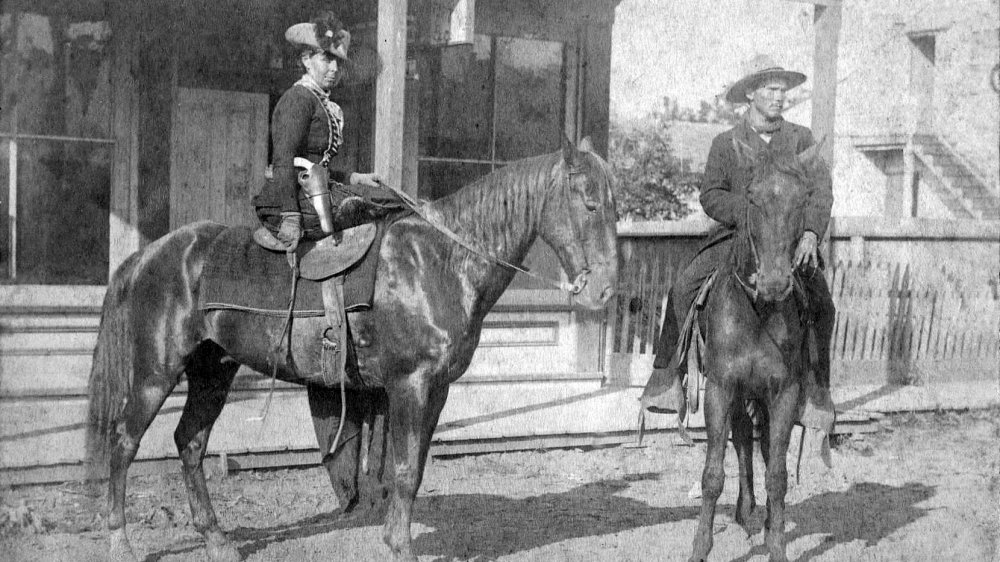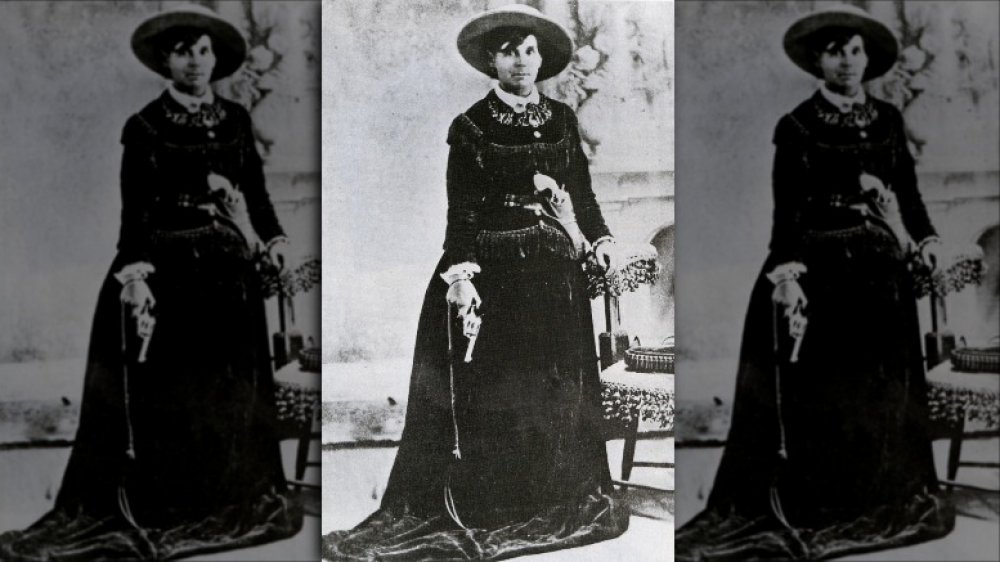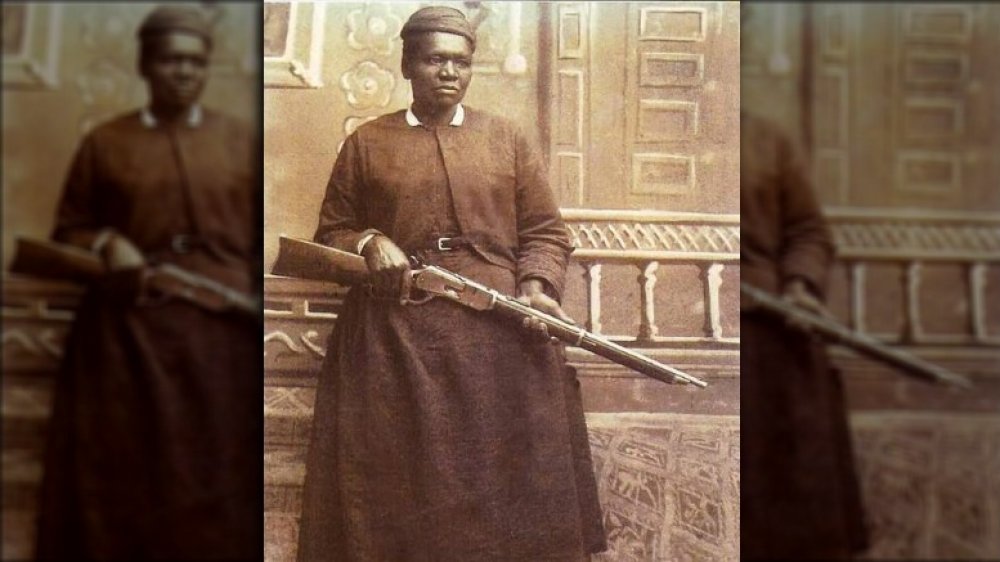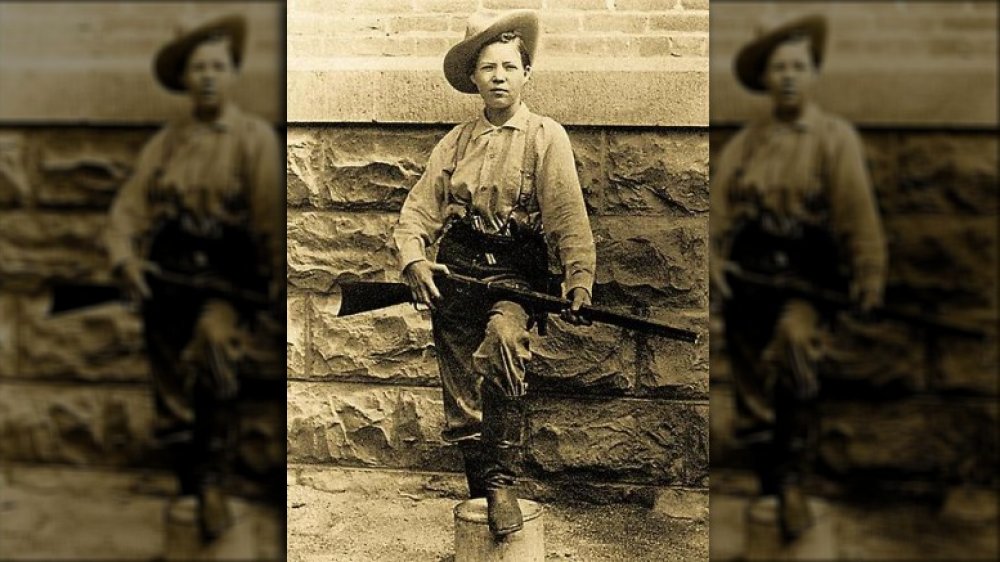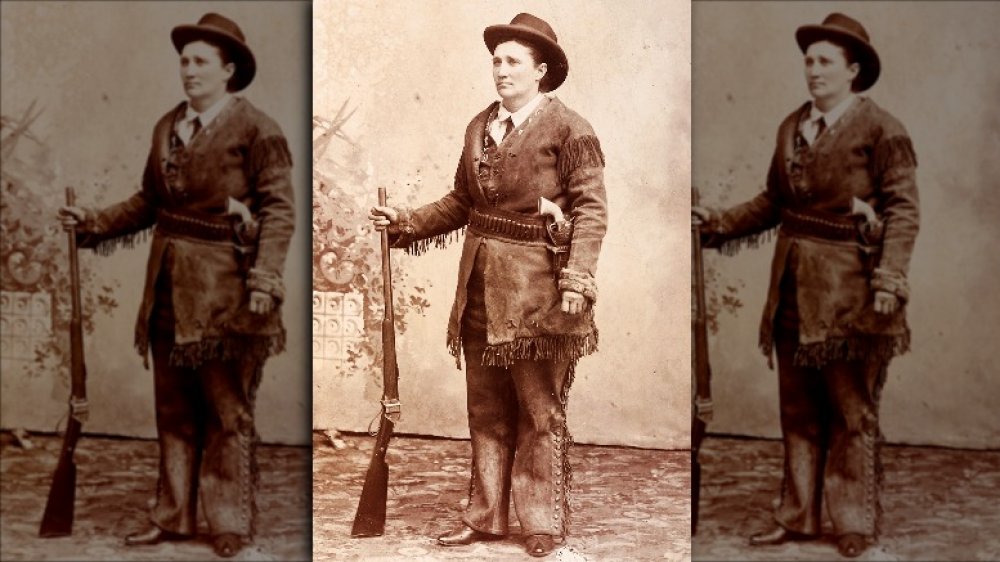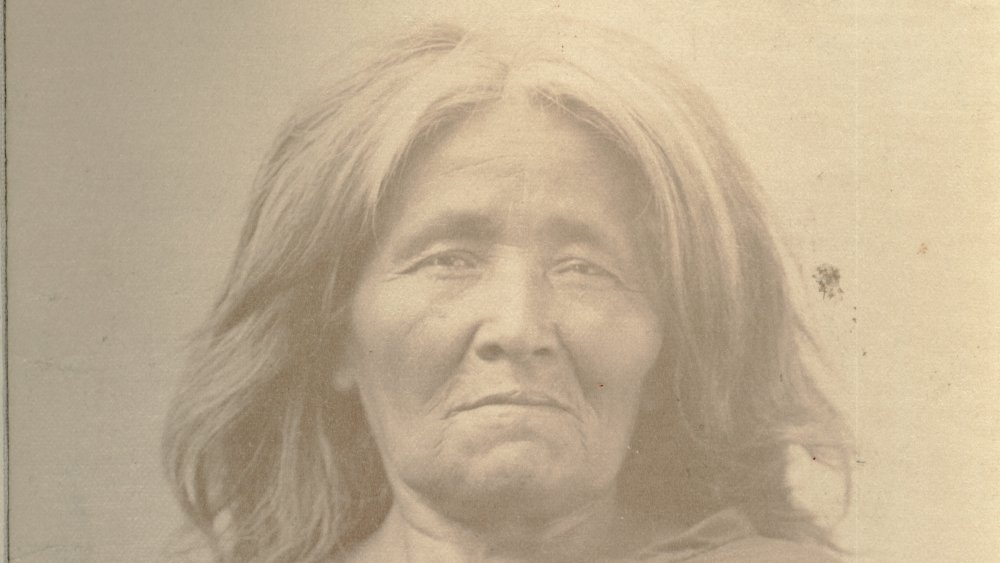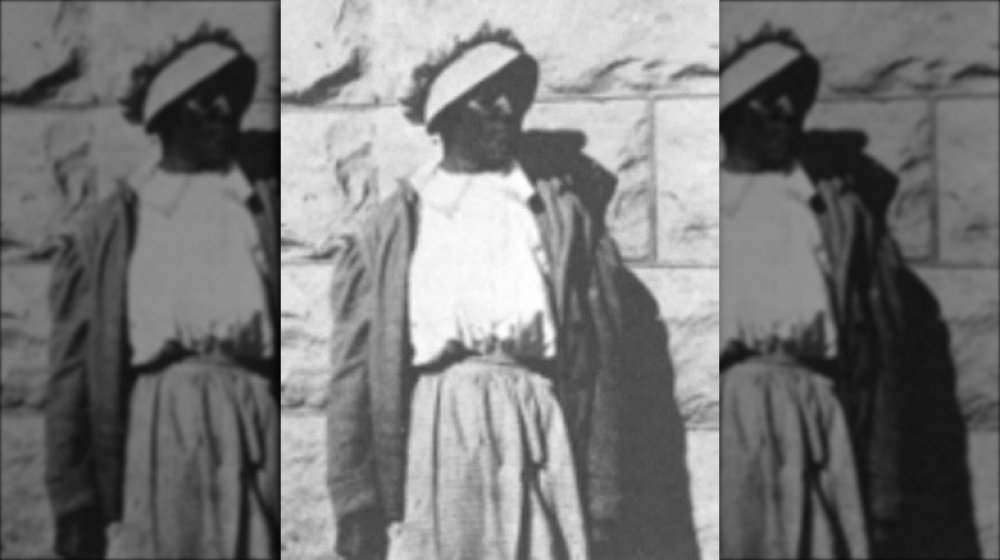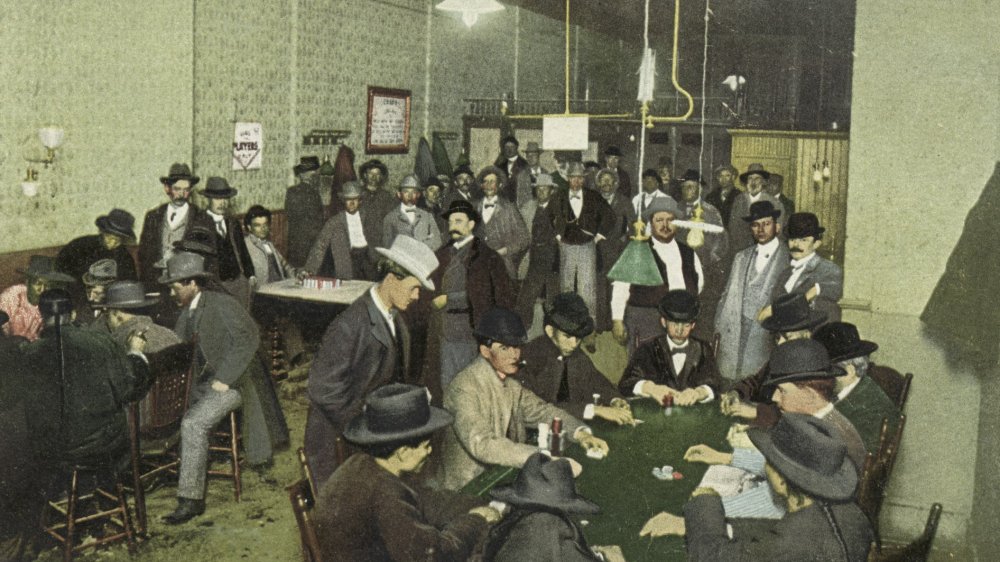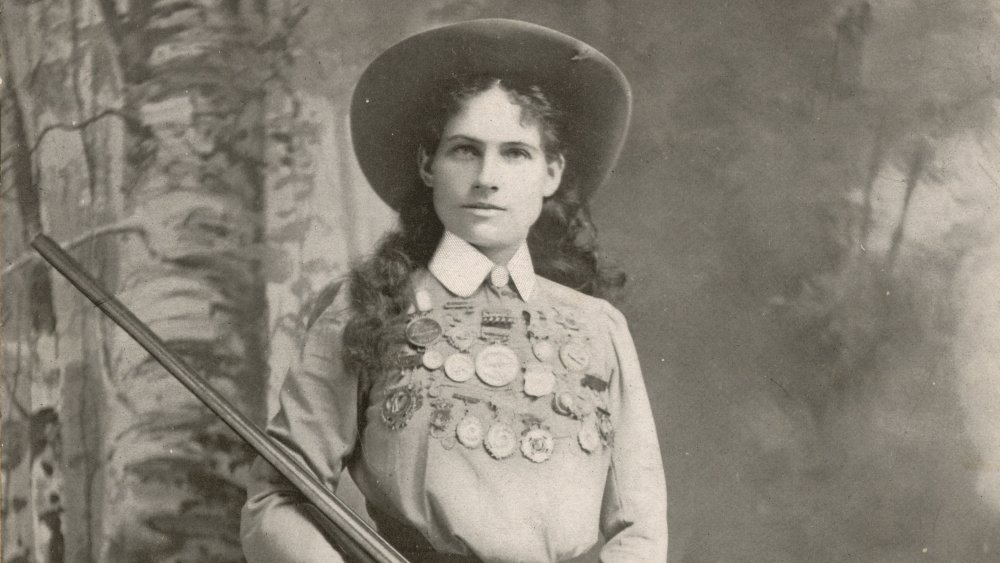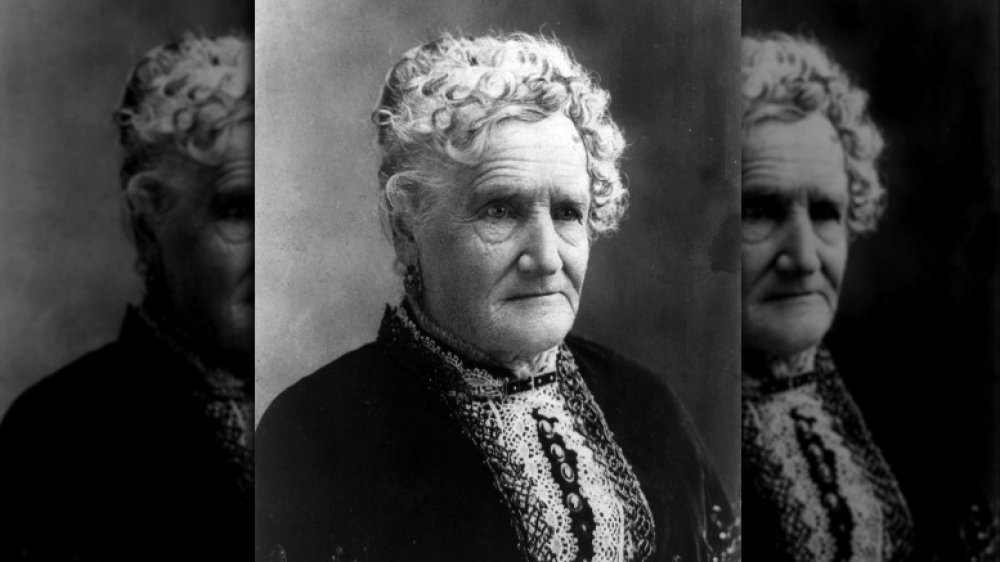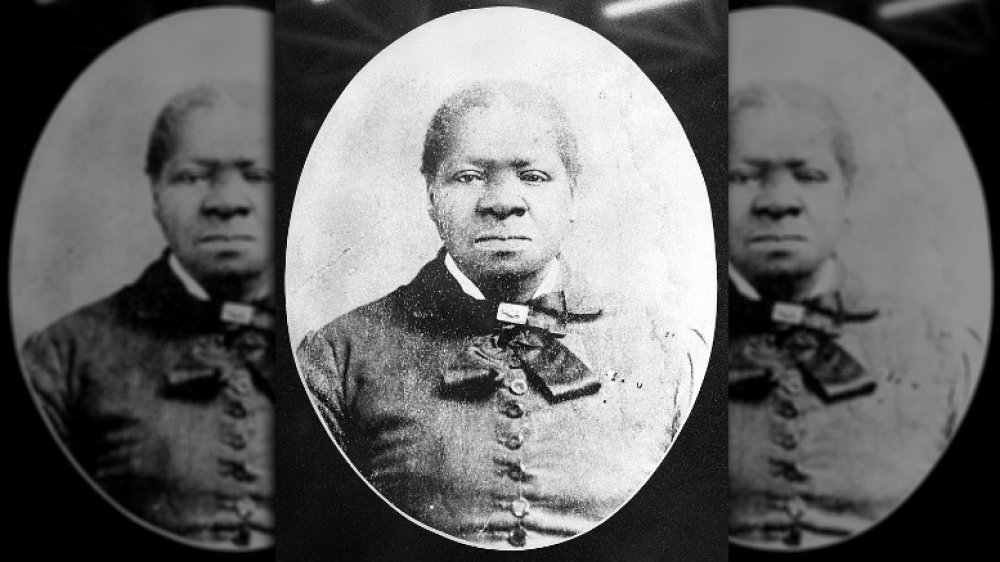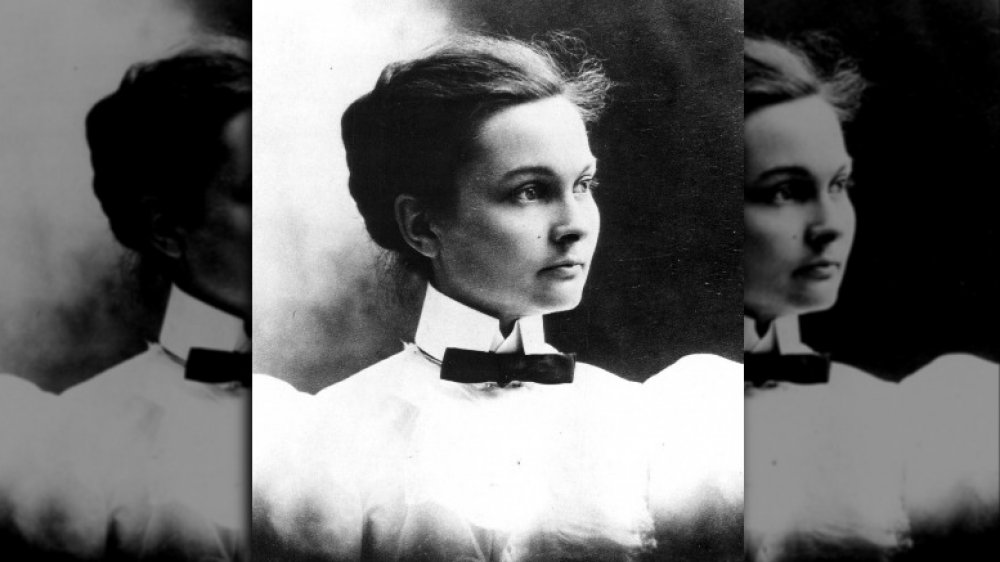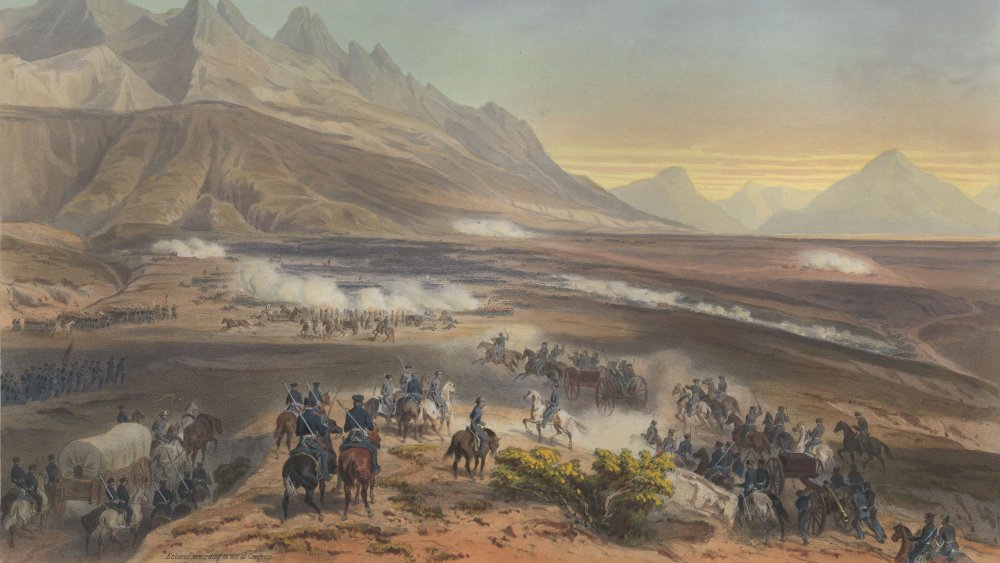The Toughest Women In The Wild West
Many of us love tales of the Wild West, full of rollicking adventure, dramatic landscapes, and colorful characters. Yet, the truth of life in this place and time was rarely easy for the people who actually had to live there. Things like medical care or law enforcement could be hard to find in the dispersed landscape of the American frontier.
To be a woman there was even more difficult. The time of the Wild West, defined by the Library of Congress as 1865-1900, was also a time of entrenched patriarchy and little regard for women's rights. It wasn't all bad, Time reports. The West offered the opportunity for some women to own land, run businesses, and even change their identities entirely. To take advantage of these opportunities, one had to be both lucky and exceedingly persistent.
For a woman to not only survive, but to become renowned or notorious, required a very persistent kind of grit. That toughness came out in different ways, from serving as agents of the law, to fighting against it, and everything in between. Regardless of how it was expressed, you can't deny that these Wild West women were some of the toughest to make their mark in the history of the Wild West.
Belle Starr was a notorious bad girl of the Wild West
As History reports, things initially looked pretty boring for Belle Starr. Born Myra Belle Shirley in 1848, she was an educated farm girl who looked as if she would become an unremarkable middle-class wife.
Then, the Civil War happened. After the family business folded and Starr's brother died in the war, the family moved to Texas. That's where Starr began to move in some pretty rough circles. By 1866, she was married to Jim Reed, a notorious outlaw. Only three years later, she was reportedly joining him to steal livestock and money around Dallas, Texas.
As Starr's notoriety grew, so did her character as the "bandit queen." That is, until Reed was shot dead in August 1874. According to HistoryNet, Starr dipped out of the historical record for a few years, reemerging when she married Sam Starr on June 5, 1880. Remarried, Belle was seemingly changed, now reluctant to take part in criminal activity and writing that she wanted "to live out her time in peace."
Yet, by the summer of 1882, Belle and Sam were charged with stealing horses. After their release, the two fell back into a criminal lifestyle, with Belle reportedly dressing as a man and taking part in robberies. A court discharged her in June 1886. Belle was shot by an unknown assailant in 1889, having made enough enemies through criminal activity and feuding that her murder remains unsolved today.
Mary Fields kept the stagecoach safe
According to the Smithsonian National Postal Museum, Mary Fields, known as "Stagecoach Mary," was born into slavery around 1833. After she was emancipated towards the end of the American Civil War, Fields moved from West Virginia and went up the Mississippi as a worker on various steamboats. She ended up in Toledo, Ohio, working at a convent. She may have eventually left to help take care of a sick friend, ending up in Montana.
She worked for Saint Peter's Mission near Cascade, Mont., but was dismissed because of her drinking and rowdy behavior. After a few failed businesses, Mary won a contract as a Star Route Carrier, meaning she would be an independent contractor delivering mail throughout northern Montana.
In 1895, when she was awarded the contract, Montana was an especially harsh place, feared for its lawlessness and extreme cold weather. Fields, the first African-American woman to receive the contract, had to be even tougher. She became widely known for her fearlessness as she protected the mail from bandits, HistoryNet reports. Yet, she had a softer side. By her retirement, she was known to be especially kind to children, was granted free drinks and food by local business owners, and had even become the mascot of the local baseball team.
Pearl Hart was a "lady bandit" of the Wild West
As per History, little is known about Pearl Hart's early life. We know that she was born in Canada in 1871, married when she was 16, and then shortly thereafter left her abusive husband. Hart next showed up in 1892 in Phoenix, Ariz. When her boyfriend left for the Spanish-American War, Hart moved to Globe, Ariz., and took up with a man named Joe Boot.
Soon, the pair hatched a plan to hold up a stagecoach for quick cash. They did so, taking over $400 in cash, but left such an obvious trail that they were soon arrested. After only a year in the Yuma Territorial Prison, Hart is said to have become pregnant, AZ Central reports. Rather than explain how a woman may have gotten into such a state while in custody, Gov. Alexander O. Brodie of the Arizona Territory pardoned her.
Though she had become something of a minor celebrity, entertaining all manner of visitors and reporters in her cell, Hart's life after her release remains something of a mystery. Legends of America claims that she was arrested for minor theft in Kansas City, under the name of Mrs. L.P. Keele. In 1924, she also supposedly visited the courthouse where she was tried years before. An attendant said that she told him "nothing has changed," then dramatically revealed that she was none other than "Pearl Hart, the lady bandit."
Calamity Jane had a hard life as a woman of the West
The hard-living Martha Jane Cannary gained the attention of many over the course of her wild and complicated life as "Calamity Jane." Biography reports that, at the tender age of 12, Cannary was an orphan who had to somehow survive on her own in the hardscrabble environment of 1860s Utah. The powerfully built young woman began dressing and acting as a man, taking on arduous work. Some rumors claim that she may have also engaged in occasional sex work to survive.
As Legends of America reports, Cannary eventually made her way to Deadwood, S.D., where she met up with lawman and eventual folk hero Wild Bill Hickok. Some believe that Calamity Jane, as she was now known, had an affair with Hickok, though historians remain skeptical of the claim. Indeed, the hard-drinking, hard-living Calamity Jane was known to spin a tale or two herself, making it hard to pin down the truth of her life. Some of the stories do depict her softer side, like when she is said to nursed smallpox victims in Deadwood.
Calamity Jane's notoriety later gained her a spot as a sharpshooter in Buffalo Bill's Wild West Show by 1895, says HistoryNet. This success was short-lived, however, as the effects of her hard life and the intermittent nature of show business caught up with her. She died aged only 51 in August 1903, suffering from persistent health problems reportedly made worse by alcoholism.
Dilchthe made a monumental trek home
Dilchthe, a seemingly unremarkable grandmother and member of the Warm Springs Apache clan, was thrust into history when her group was captured by mercenaries in the 1860s. According to HistoryNet, the experience began near modern-day Douglas, Ariz. The mercenaries executed the men in her group, but Dilchthe and the other women were forced to march south, where they were sold into slavery in Mexico's Baja California peninsula. When she ended up working on a hacienda, Dilchthe , along with a few other women, escaped and began the long trek back to her homeland.
As related in Please, General Custer, I Don't Want to Go: True Tales of the Old West, the survival skills of even a seasoned Native woman like Dilchthe were sorely tested by the journey. She nearly drowned when leading the group across a river. They suffered the intense heat of the Yuma Valley. Towards the end of their story, the women were attacked by rival tribes, leaving only two survivors. Dilchthe and the other woman continued for days, eventually collapsing from exhaustion and hunger in the desert. In a last-ditch effort, Dilchthe built a signal fire. The group that found the women included Dilchthe's son-in-law, who was delighted to see her and welcome her home as a hero.
Cathay Williams hid her gender
Believe it or not, the life of a soldier in the United States Army just after the Civil War wasn't so bad. At least, it could be attractive if you were someone who had already been subjected not just to the horrors of war but to the cruelty of slavery in the American South. For Private William Cathay, marching hundreds of miles with the 38th Infantry, an all-Black regiment, wasn't so bad.
It could have been much worse if Private Cathay's true identity was known. For, as the National Park Service reports, William Cathay was actually Cathay Williams, a woman who had enlisted in 1866, in St. Louis, Mo.
Not much is known about her early life, HistoryNet says, though we can guess that she was in her teens or early 20s when she enlisted, would have carried the same equipment, and was subject to the same rigorous conditions as her male counterparts. Despite her frequent visits to the infirmary and a bout with smallpox, she didn't reveal her gender until 1868. She was discharged soon after, though the court documents refer to the discharged soldier as "he," possibly because Williams' officers feared a court martial.
Williams is the only known woman to serve as a "buffalo soldier," defined by History as African-American soldiers who generally served in the American West after the Civil War.
Eleanore Dumont was a woman who commanded the blackjack tables
Eleanore Dumont was likely born in New Orleans some time around 1829, Legends of America reports. She traveled west during the California Gold Rush, arriving in San Francisco by 1849. There, she pretended to be an elegant French woman called Simone Jules, presumably on the assumption that an exotic continental lady could gain more attention than a plain old American. She soon became known as a professional gambler, playing vingt-et-un, a precursor to blackjack.
By 1854, Dumont created a stir in Nevada City, Calif., where she declared that she was to open a fine gambling emporium. Men swarmed to the swanky establishment. She was also a popular card dealer in such places as Deadwood, S.D., where she is rumored to have taught Calamity Jane how to play poker.
Dumont briefly tried her hand at ranch management but otherwise spent most of her life as a gambler and businesswoman. As she aged, Fascinating Women in California History says, Eleanore developed a line of hair on her upper lip, earning the moniker "Madame Moustache." Eventually, she became an actual madam and began moonlighting as a bordello operator. When financial trouble began to dog her in 1879, she is said to have drunk wine with morphine, a fatal mixture. Her body was found a mile outside of Bodie, Calif.
Annie Oakley was an astounding sharpshooter
According to the National Women's History Museum, Annie Oakley was born Phoebe Ann Moses in Darke County, Ohio, in 1860. Her father and stepfather both died suddenly, leaving her mother, Susan, with seven children and little income. Oakley, who went by "Annie," was sent to live with and work for a local family. When she was only eight, she began to hunt, selling the animals she shot to keep up her family's finances.
Oakley, who chose her stage name based on a nearby Ohio town, quickly realized that she was an incredibly accurate shot. She was so good, History reports, that her talent earned enough money to pay off the mortgage on her family home. Oakley began entering shooting competitions, besting one sharpshooter named Frank Butler so impressively that they married within a year.
The Wild West came into her life when William "Buffalo Bill" Cody needed a new sharpshooter for his popular traveling extravaganza, the Wild West Show. With her skill and stage presence, Oakley was a huge hit in Buffalo Bill's extravaganza. As per Biography, she wowed audiences by shooting while looking into a mirror, nicking a cigarette in Butler's mouth, and shooting holes through airborne playing cards. Native American leader Sitting Bull also met with her in 1884. He was reportedly so impressed by her that he adopted Oakley, naming her "Little Sure Shot".
Esther Hobart Morris dispensed law and order in the Wild West
The state of Wyoming made U.S. history in December 1869. That's when the territory became the first place in the nation to give women the right to vote and hold office, The New York Times reports. Not long after, Esther Hobart Morris became the first female justice of the peace for Wyoming. It was just one achievement in a life that had produced a considerably tough woman.
Her life preceding this event wasn't an easy one. According to the National Park Service, she was a successful business owner in New York, working primarily as a hat and dress maker. Morris was by then an avowed abolitionist and women's rights advocate. After her first husband died, Esther and her young son moved to Illinois, but sexist laws made it difficult for her to manage her late husband's estate. With her second husband, John, she moved to Wyoming in 1868. John proved to be such a troublesome drunk that, after Morris was no longer a judge, she had him arrested.
When Morris became a justice in 1870, she was still faced with a rough world. Her purview included South Pass City, which included many rowdy establishments like saloons and brothels. Though she only served a little more than eight months, The New York Times reports that, at least once, she was referred to as "the terror of all rogues."
Bridget Mason rose from slavery
Bridget "Biddy" Mason rose from slavery to become a highly successful entrepreneur in 19th century California, becoming one of the biggest philanthropists in early Los Angeles. It was no easy path to get there.
According to the National Park Service, Mason began her life in 1818 Mississippi, long before the Civil War and the Emancipation Proclamation that would free African-American slaves. Her final master, a Mormon man named Robert Marion Smith, decided in 1848 that he would join the growing Mormon settlement in Utah. Mason walked an estimated 1,700 miles to the Salt Lake Valley, all while taking care of the Smith family and her own young children.
Things changed with Smith's decision to move to California, though he would have known that slavery was illegal in that state. After five years and a thwarted move out of the state, Mason successfully petitioned for her freedom in 1856, along with 13 of her family members. Mason moved to Los Angeles, says Legends of America, where she worked as a nurse while carefully saving her money and buying land. Mason was so successful that she eventually amassed a small fortune and became a well-known philanthropist. She's known to have built an elementary school, fed poor people, and organized the First African Methodist Episcopal Church, the oldest African-American church in Los Angeles.
Susan Anderson brought medical care to the Rocky Mountains
Susan Anderson had to travel far to get to her life in the Rocky Mountains, says the biography Doc Susie. She was born in Indiana in 1870, moving to Colorado with her family after she graduated high school in 1891. She lived in the mining town of Cripple Creek for a couple of years before leaving for medical school. After earning her degree, she returned to her family in Cripple Creek and set up her first practice.
In 1900, Legends of America reports, Anderson saw the death of her brother and the breakup of her relationship with her fiancé. Perhaps wanting to leave a place that held painful memories, she left for Denver. Yet, patients in the city were reluctant to see a female doctor. She then moved to Greeley, Colo., where she worked as a nurse and then fatefully contracted tuberculosis.
At the time, most tuberculosis patients were advised to seek cold, dry climates. Anderson moved to the mountain town of Fraser, Colo., in 1907, hoping only to recuperate from her illness. Eventually, however, word got out that she was a doctor. Soon, local people were asking for her help. "Doc Susie," as she came to be known, was often the only doctor for many miles. She made house calls on foot, crossing the intense terrain at over 8,000 feet above sea level until her retirement in 1956.
Sarah Bowman wasn't scared of war
Standing over 6 feet tall and nicknamed "The Great Western," Sarah Bowman was a striking figure. Her actions during the Mexican-American War made her even more unforgettable.
According to the Texas State Historical Association, Bowman was born around 1812, likely in either Tennessee or Missouri. Little else is known about her life before she began making waves in Texas in 1845. In her first documented appearance, she followed her latest husband, a soldier, to Corpus Christi, Texas. Bowman became legendary when she offered to cross the Colorado River in 1846 and beat the enemy herself if Gen. Zachary Taylor would just give her permission. She refused to shelter during the bombardment of Fort Brown in 1846, instead operating the officers' mess while under heavy fire.
Bowman married various men throughout her life, sometimes without the hindrance of legal documents or clergy members. She may or may not have followed one to Saltillo, now in modern Mexico, says the University of Texas. It was there that she helped at the Battle of Buena Vista, where she reloaded weapons, carried wounded soldiers to safety, and allegedly beat a retreating soldier for his cowardice. She married her final husband, Albert Bowman, and moved with him to Fort Yuma, Ariz. She ran a variety of businesses there, including hotels, brothels, and restaurants, before supposedly dying of a spider bite in the 1860s.
